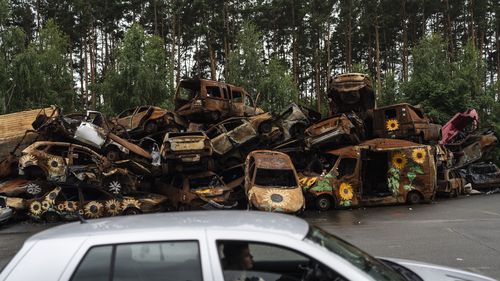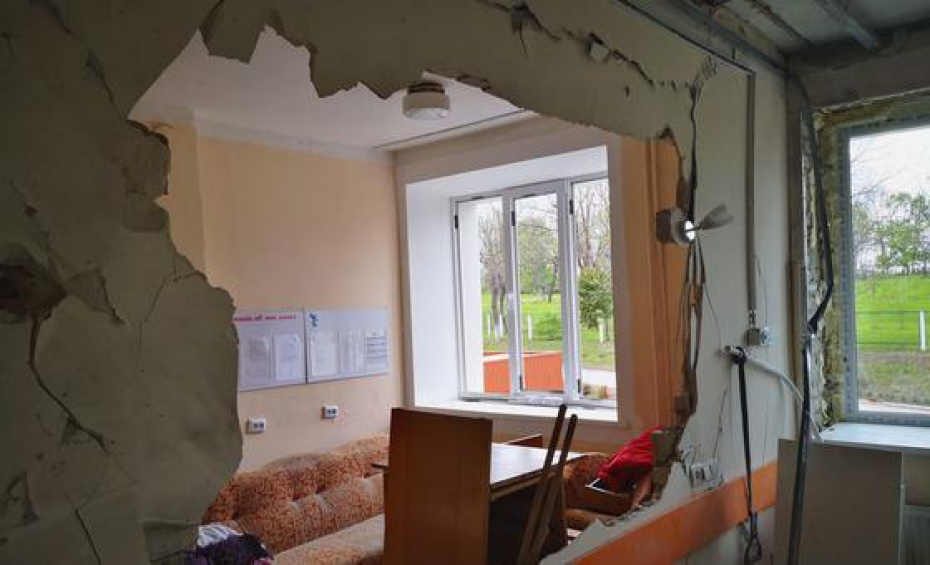US to send cluster munitions banned by over 100 nations to Ukraine after months of debate


Risk to civilians

Biden reluctant at first

Banned by many countries, cluster munitions leave unexploded bombs that pose a risk to civilians for decades to come.
US to send cluster bombs to Ukraine despite humanitarian concerns
Published On 7 Jul 2023
Washington, DC – The United States has authorised the transfer of cluster munitions to Ukraine against the objections of rights advocates who have been calling for a ban on the weapons, which they say endanger civilians.
The administration of President Joe Biden confirmed the move on Friday, arguing that US-made cluster bombs are safer than the ones Russia is already using in the conflict. The transfer comes as Ukraine pushes on with a counteroffensive against Russian troops in the east of the country.
“We recognise that cluster munitions create a risk of civilian harm from unexploded ordnance,” US national security adviser Jake Sullivan told reporters.
“This is why we’ve deferred the decision for as long as we could. But there is also a massive risk of civilian harm if Russian troops and tanks roll over Ukrainian positions and take more Ukrainian territory and subjugate more Ukrainian civilians.”
Sullivan added that cluster munitions would serve as a “bridge” to supplement conventional artillery as the US ramps up production of regular bombs and shells for Ukraine.
Biden later told CNN that it was a “very difficult decision” on his part, adding that the “Ukrainians are running out of ammunition”.
The weapons are part of a tranche of US military assistance to Ukraine that also includes armoured vehicles and anti-armour weapons, the Pentagon announced.
Rights advocates slammed the Biden administration’s decision, highlighting their threat to Ukrainian civilians.
Sarah Yager, the Washington director at Human Rights Watch, called the US move “devastating”.
“They are absolutely awful for civilians.” Yager told Al Jazeera in a television interview. “I think when legislators and policymakers here in the United States see the photos coming back of children with missing limbs, parents injured, killed by our own American cluster munitions, there’s going to be a real awakening to the humanitarian disaster that this is.”
Why the US sending cluster bombs to Ukraine is significant
UN opposition
Each cluster bomb can contain hundreds of smaller explosives that spread across a targeted area, but not all of these bomblets detonate on impact. The unexploded bombs, known as duds, can remain embedded in the ground for years, posing a serious danger to civilians, most notably children.
While cluster munitions are not banned internationally, more than 120 countries – including most NATO members – have signed on to a convention prohibiting their use. The US, Ukraine and Russia are not party to that agreement.
On Friday, Farhan Haq, a spokesperson for United Nations Secretary-General Antonio Guterres, reiterated the UN chief’s support for the Convention on Cluster Munitions.
“He wants countries to abide by the terms of that convention, and so as a result, of course, he does not want there to be continued use of cluster munitions on the battlefield,” Haq said.
Germany, a NATO member and top Ukraine ally, has also voiced opposition to sending cluster munitions to Ukraine.
But NATO Secretary-General Jens Stoltenberg suggested that the alliance does not take a position on the issue, leaving it to the individual states to make their own policies.
“Cluster munition is already in use in the war on both sides. The difference is that Russia uses the cluster munitions in a war of aggression to occupy, to control, to invade Ukraine while Ukraine is using it to defend itself against aggression,” Stoltenberg told Al Jazeera’s diplomatic editor James Bays in an interview.
But Yager dismissed the argument that Russia’s use of the weapons justifies further deployment of cluster munitions by Ukraine. “The fact that Russia is using them is just another reason why they should not be used,” she said.
With the US providing military support, Ukraine has been making only modest gains in a much-anticipated counteroffensive launched last month.
Last year, US envoy to the UN Linda Thomas-Greenfield slammed Russia for using “exceptionally lethal” weapons in Ukraine, including cluster munitions.
On Friday, Sullivan said Washington has “written assurances” from Kyiv that it would use the cluster munitions in a careful way to minimise civilian harm.
How cluster munitions work
Patrick Fruchet, a landmine clearance expert, said explosive remnants of war – bombs that “fail to go bang” when launched – are a major source of risk in conflict areas.
Fruchet said the main concern with cluster munitions is their failure rate and their “twitchy” qualities, which makes the unexploded devices vulnerable to detonation when handled.
“You see a lot of children coming upon novel-looking devices and being attracted to them because they’re unusual, … and there’s a tendency to pick them up,” he said.
The Pentagon said on Thursday that the cluster bombs it is considering providing to Ukraine have a dud rate lower than 2.35 percent.
But Fruchet said the dud estimate on the explosives are unreliable, citing his experience with the UN Mine Action Service in Afghanistan, where he dealt with cluster bombs with a supposed failure rate of 5 percent.
“The teams on the ground, we saw failure rates of up to 40 percent based on going out and clearing the space – knowing how many cluster munitions would have been in one clamshell and then basically counting how many we had to clear,” he said.
Unlike landmines, cluster bombs are not designed to be triggered by the proximity of people or vehicles; they are meant to explode when dropped. But once left unexploded, the bomblets “function in practice very similarly to landmines” – they go off if they are disturbed, Fruchet told Al Jazeera.
The duds can still detonate decades after they are dropped. “There’s no reason to believe that they ever really become inert, that they ever become harmless,” Fruchet said. “These things are made to an industrial standard. They’re often stored for a long time.”
For example in south Lebanon, cluster munitions fired by Israel during the 2006 war continue to endanger civilians today.
On Friday, Amnesty International slammed the US decision and called on Washington to reconsider its policy.
“The USA’s plan to transfer cluster munitions to Ukraine is a retrograde step, which undermines the considerable advances made by the international community in its attempts to protect civilians from such dangers both during and after armed conflicts,” the group said in a statement.
SOURCE: AL JAZEERA
The Canadian Press
Thu, July 6, 2023

WASHINGTON (AP) — The Biden administration has decided to provide cluster munitions to Ukraine and is expected to announce on Friday that the Pentagon will send thousands as part of the latest military aid package for the war effort against Russia, according to people familiar with the decision.
The decision comes despite widespread concerns that the controversial bombs can cause civilian casualties. The Pentagon will provide munitions that have a reduced “dud rate,” meaning there will be far fewer unexploded rounds that can result in unintended civilian deaths.
U.S. officials said Thursday that the cluster munitions would be part of about $800 million in new military assistance to Ukraine.
Long sought by Ukraine, cluster bombs are weapons that open in the air, releasing submunitions, or “bomblets,” that are dispersed over a large area and are intended to wreak destruction on multiple targets at once.
The officials and others familiar with the decision were not authorized to publicly discuss the move before the official announcement and spoke on condition of anonymity.
Ukrainian officials have asked for the weapons to aid their campaign to push through lines of Russian troops and make gains in the ongoing counteroffensive. Russian forces are already using cluster munitions on the battlefield, U.S. officials have said.
According to the International Committee of the Red Cross, some cluster munitions leave behind “bomblets’’ that have a high rate of failure to explode — up to 40% in some cases. U.S. officials said Thursday that the rate of unexploded ordnance for the munitions that will be going to Ukraine is less than 3% and therefore will mean fewer threats left behind to civilians.
Cluster bombs can be fired by artillery that the U.S. has provided to Ukraine, and the Pentagon has a large stockpile of them.
The last large-scale American use of cluster bombs was during the 2003 invasion of Iraq, according to the Pentagon. But U.S. forces considered them a key weapon during the invasion of Afghanistan in 2001, according to Human Rights Watch. In the first three years of that conflict, it is estimated the U.S.-led coalition dropped more than 1,500 cluster bombs in Afghanistan.
Proponents of banning cluster bombs say they kill indiscriminately and endanger civilians long after their use. Groups have raised alarms about Russia’s use of the munitions in Ukraine.
A convention banning the use of cluster bombs has been joined by more than 120 countries who agreed not to use, produce, transfer or stockpile the weapons and to clear them after they’ve been used.
The United States, Russia and Ukraine are among the countries that have not signed on.
It is not clear how America’s NATO allies would view the U.S. providing cluster bombs to Ukraine and whether the issue might prove divisive for their largely united support of Kyiv. More than two-thirds of the 30 countries in the alliance are signatories of the 2010 convention on cluster munitions.
Laura Cooper, a deputy assistant secretary of defense focusing on Russia and Ukraine, recently testified to Congress that the Pentagon has assessed that such munitions would help Kyiv press through Russia’s dug-in positions.
____ AP Diplomatic Writer Matthew Lee contributed to this report.
Nomaan Merchant, Lolita C. Baldor And Ellen Knickmeyer, The Associated Press
Madeline Halpert - BBC News, New York
Fri, July 7, 2023

President Joe Biden delivers remarks on the U.S. economy at a factory that makes solar energy microinverters South Carolina on July 6, 2023
The US is planning to send Ukraine a cluster munitions package to help in its counteroffensive against Russia, US media reports.
Ukraine has been asking for the weapons for months amid an ammunition shortage.
Cluster munitions - which are banned by more than 100 countries - are a class of weapons that contain multiple explosive bomblets called submunitions.
The Biden administration is expected to announce the package on Friday, the BBC's US partner CBS News reports.
US officials had reportedly been hesitant to supply Ukraine with cluster munitions as they can kill indiscriminately over a wide area, threatening civilians. The US has a stockpile of these cluster bombs, which were first developed during World War II.
The munitions are controversial because of their high failure rates, meaning unexploded bomblets can linger on the ground for years and possibly detonate later on.
US law prohibits the transfer of cluster munitions with bomblet failure rates higher than 1% - meaning more than 1% of the bomblets in the weapon do not explode - but President Joe Biden is able to bypass this rule.
Defence Department officials told reporters on Thursday the Biden administration was considering sending cluster munitions with a failure rate lower than 2.35%.
The Pentagon noted that Russia has already been using cluster bombs in Ukraine with even higher failure rates. A United Nations investigation found Ukraine has likely used them as well, though the country has denied doing so.
Evidence of widespread use of cluster munitions in Kharkiv
Officials are planning to send artillery shells to Ukraine, with each containing 88 separate bomblets, according to US media reports. They would be fired from Howitzer artillery weapons already deployed by the Ukrainian army.
The aid package also includes Bradley and Stryker fighting vehicles, air defence missiles and anti-mine equipment, officials told reporters.
Human rights groups have urged Russia and Ukraine not to use cluster munitions and have asked the US not to supply them.
In a statement on Friday, the Office of the United Nations High Commissioner for Human Rights once again called on the countries not to use cluster bombs, arguing they were dangerous.
"Cluster munitions scatter small bomblets over a wide area, many of which fail to explode immediately," said office spokesperson Marta Hurtado. "They can kill and maim years later. That's why use should stop immediately."
Some US lawmakers have also asked the Biden administration not to send the weapons, arguing their humanitarian costs outweigh their benefits in the battlefield.
Defence Department official Laura Cooper told Congress last month that military analysts had found that cluster bombs would be "useful, especially against dug-in Russian positions".
The Biden administration's new weapons package is worth $800 million (£626.5m), CBS News reported.
Following months of debate within his administration, US President Joe Biden has approved the provision to Ukraine of long-sought cluster munitions, bypassing legal restrictions.
The munitions are banned in much of the world. Here is what to know about them and why they are so controversial.
What exactly are cluster munitions?
Dating back to the 1940s, cluster munitions disperse submunitions over wide areas. The munitions are launched using the same artillery the United States and other Western nations have sent to Ukraine since the start of the war, including howitzers.
The US has a stockpile of cluster munitions, but is last known to have used the weapons in battle in Iraq in 2003, according to the Associated Press. The US is not providing Ukraine with cluster bombs intended to be dropped from planes.
On Thursday, Human Rights Watch published new evidence suggesting that Ukrainian forces have already injured civilians by use of cluster munitions, which Russian forces have used far more extensively, also causing civilian deaths

CARL COURT/GETTY IMAGES
Young boys play around a spent cluster munition in Dubove, Ukraine.
Why is America sending them to Ukraine?
Facing diminishing Western stocks of artillery rounds and deeply entrenched Russian forces, the Ukrainian counteroffensive, intended to return the country to pre-invasion borders, has progressed slower than Western officials had hoped.
Amid Ukrainian frustration over Western expectations in the absence of overriding artillery superiority and fighter jets yet to arrive, President Volodymyr Zelenskyy was pushing the American government for cluster munitions, claiming they are the most effective way for Ukrainian forces to push quickly though expansive Russian trenches and deadly minefields.
Why are cluster munitions controversial?
Over 120 nations have joined a convention pledging not to use the weapons because of their indiscriminate nature.
Not only do they fall over a very wide area, which leads to potential civilian casualties during conflicts, but many submunitions fail to explode on impact. This means they can continue to kill or maim people long after a war has ended.
The International Committee of the Red Cross said in 2010 that between 10 and 40% of ordnance released by cluster munitions used in recent conflicts failed to explode immediately, presenting a major threat to civilians. The Convention on Cluster Munitions prevents the use, development, stockpiling or transfer of the munitions. But Russia, Ukraine and the US are not signatories to the agreement.
For the past seven years, the US Congress has stipulated that cluster munitions with a failure rate of more than 1% cannot be produced, transferred or used.
But the munitions in question, the M864 artillery shell, dates back to 1987 and may have a “dud” rate of 6%, according to the last public assessment by the Pentagon from over two decades ago. The Pentagon said it has more recent assessments of 2.35% or below, but that would still be above the limit set by Congress.

SCOTT OLSON/GETTY IMAGES
Residents take pictures of the remains of a missile that dropped cluster bombs in Sloviansk, Ukraine.
In its new report, Human Rights Watch accused Moscow and Kyiv of using the weapons since the February 2022 invasion, leading to deaths and serious injuries among civilians.
In one incident in the early days of the war, Ukrainian authorities and witnesses alleged Russian used the munitions in an attack on a train station that killed 50 people.
Mary Wareham, acting arms director of Human Rights Watch, said the weapons “are killing civilians now and will continue to do so for many years”.
What other nations use cluster munitions?
Evidence suggests Russia has used cluster munitions to a greater extent than Ukraine since invading the country last year.
Human rights organisations documented and heavily criticised the US over its extensive use of cluster bombs during the initial years of the Afghanistan invasion.
Israel fired millions of cluster munitions into Lebanon in 2006, during a short conflict against Hezbollah, which also fired cluster munitions into Israel. The United Nations estimated that of the 4 million submunitions fired by Israel, up to 1 million remained unexploded at the end of the conflict, killing Lebanese civilians.
The munitions have been used by both Russian and Syrian forces in Syria, destroying cities like Aleppo and killing civilians amid the civil war there.
Human Rights Watch documented Saudi Arabia using cluster munitions made by the US against Houthi rebels in Yemen, a move the group said leaves civilians in an already deadly region in added danger due to unexploded ordnance.




